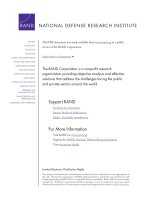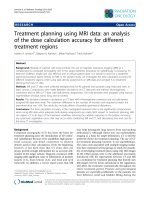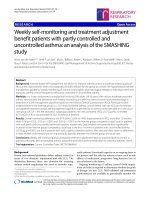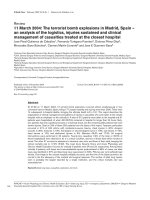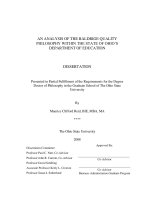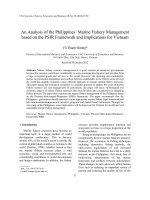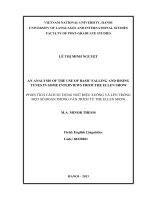An analysis of the causes leading to construction supply chain disruption during the construction stage
Bạn đang xem bản rút gọn của tài liệu. Xem và tải ngay bản đầy đủ của tài liệu tại đây (1.56 MB, 147 trang )
VIETNAM NATIONAL UNIVERSITY HO CHI MINH CITY
HO CHI MINH CITY UNIVERSITY OF TECHNOLOGY
NGUYEN VAN BA
AN ANALYSIS OF THE CAUSES LEADING TO
CONSTRUCTION SUPPLY CHAIN DISRUPTION DURING
THE CONSTRUCTION STAGE
Major: CONSTRUCTION MANAGEMENT
Major ID: 8580302
MASTER’S THESIS
HO CHI MINH CITY, JULY 2023
THIS RESEARCH IS COMPLETED AT:
HO CHI MINH CITY UNIVERSITY OF TECHNOLOGY – VNU-HCM
Supervisor 1: Dr. Nguyen Thanh Viet
Supervisor 2: Dr. Nguyen Anh Thu
Examiner 1: Assoc. Prof. Dr. Pham Vu Hong Son
Examiner 2: Dr. Pham Hai Chien
This master’s thesis is defended at HCM City University of Technology,
VNU-HCM on July 10th 2023
Master’s Thesis Committee:
(Please write down full name and academic rank of each member of the
Master’s Thesis Committee)
1. Assoc. Prof. Dr. Luong Duc Long
- Chairman
2. Assoc. Prof. Dr. Tran Duc Hoc
- Member, Secretary
3. Assoc. Prof. Pham Vu Hong Son
- Reviewer 1
4. Dr. Pham Hai Chien
- Reviewer 2
5. Dr. Nguyen Hoai Nghia
- Member
Approval of the Chairman of Master’s Thesis Committee and Dean of
Faculty of Civil Engineering after the thesis being corrected (If any).
CHAIRMAN OF THESIS COMMITTEE
Assoc. Prof. Dr. Luong Duc Long
DEAN OF FACULTY OF CIVIL
ENGINEERING
Assoc. Prof. Dr. Le Anh Tuan
i
VIETNAM NATIONAL UNIVERSITY-HO CHI MINH CITY
HO CHI MINH CITY UNIVERSITY OF TECHNOLOGY
SOCIALIST REPUBLIC OF VIETNAM
Independence – Freedom – Happiness
THE TASK SHEET OF MASTER’S THESIS
Full name: Nguyen Van Ba
Student code: 2270351
Date of birth: 10/06/1984
Place of birth: Thanh Hoa
Major: Construction Management
Major code: 858032
I.
THESIS TOPIC:
An Analysis of the Causes leading to Construction Supply Chain Disruption
during the Construction Stage.
Phân tích các nguyên nhân dẫn đến đứt gãy chuỗi cung ứng trong giai đoạn xây
dựng dự án.
II.
TASKS AND CONTENTS: The construction supply chain disruption
III. TASKS STARTING DATE: February 2nd, 2023
IV. TASKS ENDING DATE: June 10th, 2023
V.
SUPERVISORS: Dr. Nguyen Thanh Viet and Dr. Nguyen Anh Thu
Ho Chi Minh City, June 10th, 2023
SUPERVISOR 2
SUPERVISOR 1
Dr. Nguyen Anh Thu
Dr. Nguyen Thanh Viet
HEAD OF DEPARTMENT
Dr. Le Hoai Long
DEAN OF FACULTY OF CIVIL ENGINEERING
Assoc. Prof. Dr. Le Anh Tuan
ii
ACKNOWLEDGEMENT
I would like to express my sincere appreciation and gratitude to many people
who directly and indirectly contributed to this study. Without their guidance, support
and participation, this study wouldn’t come into fruition.
First and foremost, I am sincerely grateful to Dr. Nguyen Thanh Viet and Dr.
Nguyen Anh Thu, my thesis instructors and my lecturer Assoc. Prof. Dr. Do Tien
Sy. They give me not only large number of significant advices, guidance and
comments, but also motivative supervision, and encouragement.
Sincere thanks to friends, experts who are working in the construction field in
Vietnam, they have been patiently and seriously giving me many advices and their
opinions during data collection, without their helping, this master thesis could not be
done.
I would like to express my gratitude to IMP Office and Department of
Construction Engineering and Management, for their valuable support during my
study for master degree. I also thank project owners, contractors, consultants, and
other professionals for their willingness to participate in the lengthy questionnaire
survey and sharing their valuable time for the interviews to collect data. Their
valuable and concerned opinions would bring the accurate results and finding of
this thesis.
Last but not least, I want to express my sincere gratitude to my family for their
support and affection. They never stopped believing in me and continued to
support and encourage me as I worked on my master's thesis.
iii
ABSTRACT
The construction industry is a significant contributor to the Vietnamese economy,
with a value of approximately $11 billion and around 10-million-man powers being
involved in recent years. However, the construction supply chain in Vietnam is highly
complex and fragmented, which makes it vulnerable to disruptions. especially, the
construction supply chain disruptions had caused a wide-scale impact to the
construction industry in various developing countries including the Vietnam
construction industry, with increasing report on project performance deficiencies such
as cost and time overruns of severe magnitudes. Thus, this research aims to analyze
the causes and effects of construction supply chain disruption in Vietnam and identify
the necessary measures for mitigating these disruptions. The research will involve a
literature review and experts interview as well as questionnaires survey to whom had
rich experiences in construction supply chain disruptions across Vietnam construction
projects. Based on these data collection, Structure models are built to illustrate the
interactions among constructs and their impact on the project performance. The
purpose of this research is to provide insights into the pathogenic causes that impact
to construction supply chain disruption in Vietnam and to propose effective strategies
for managing these disruptions. The findings of this research will be useful for
stakeholders in the Vietnamese construction industry, including project owners,
contractors, suppliers, and government agencies, in improving construction supply
chain management, resilience of CSC disruptions and enhancing project outcomes,
bring more trust and reliable for long term cooperation between stakeholders.
Ultimately, this research can contribute to the sustainable growth of the Vietnamese
construction industry and the economy as a whole.
Key words: Construction Supply Chain, Construction Supply Chain disruption,
construction Supply chain risks, Construction Projects, Vietnam.
iv
TÓM TẮT LUẬN VĂN THẠC SĨ
Ngành xây dựng là nguồn góp phần quan trọng cho nền kinh tế Việt Nam, với
giá trị khoảng 11 tỷ đô la và gần 10 triệu lao động tham gia trong những năm gần đây.
Tuy nhiên, chuỗi cung ứng xây dựng ở Việt Nam là rất phức tạp và phân mảnh, điều
này làm cho nó dễ bị gián đoạn. Đặc biệt, những gián đoạn này đã gây ra ảnh hưởng
rộng lớn đến ngành xây dựng ở các nước đang phát triển, trong đó có ngành xây dựng
Việt Nam, với việc báo cáo ngày càng tăng về những suy giảm trong hiệu suất dự án
như quá trình triển khai chậm tiến độ và vượt quá chi phí được phê duyệt. Do đó,
nghiên cứu này nhằm phân tích nguyên nhân và hậu quả của gián đoạn chuỗi cung ứng
xây dựng ở Việt Nam và đề xuất các biện pháp cần thiết để giảm thiểu những gián
đoạn này. Nghiên cứu sẽ dựa trên các nghiên cứu trước đây và cuộc phỏng vấn các
chuyên gia cũng như khảo sát bằng bảng câu hỏi dành cho những người có kinh
nghiệm phong phú về gián đoạn chuỗi cung ứng xây dựng trong các dự án xây dựng ở
Việt Nam. Dựa vào việc thu thập dữ liệu này, các mơ hình cấu trúc (SEM) sẽ được xây
dựng để minh họa sự tương tác giữa các yếu tố và tác động của chúng đối với hiệu suất
dự án. Mục tiêu của nghiên cứu này là cung cấp cái nhìn sâu sắc về các nguyên nhân
gây gián đoạn chuỗi cung ứng xây dựng ở Việt Nam và đề xuất các chiến lược hiệu
quả để quản lý những gián đoạn này. Kết quả của nghiên cứu này sẽ hữu ích cho các
bên liên quan trong ngành công nghiệp xây dựng Việt Nam, bao gồm chủ đầu tư dự
án, nhà thầu, nhà cung cấp và các cơ quan chính phủ, trong việc cải thiện quản lý
chuỗi cung ứng xây dựng, phục hồi gián đoạn chuỗi cung ứng và nâng cao hiệu quả dự
án, đồng thời tạo sự tin cậy hơn trong việc hợp tác lâu dài giữa các bên liên quan.
Cuối cùng, nghiên cứu này có thể đóng góp vào sự phát triển bền vững của
ngành cơng nghiệp xây dựng và kinh tế Việt Nam nói chung.
Từ Khóa: Chuỗi cung ứng xây dựng, sự đứt gãy chuỗi cung ứng xây dựng, các rủi ro
của chuỗi cung ứng xây dựng, dự án xây dựng, Việt Nam.
v
AUTHOR’S COMMITMENT
The undersigned below:
Name
: NGUYEN VAN BA
Student ID
: 2270351
Place and date of born
: Thanh Hoa, June 10, 1984
Address
: Ho Chi Minh City
With this declaring that the master thesis entitled “AN ANALYSIS OF THE
CAUSES LEADING TO CONSTRUCTION SUPPLY CHAIN DISRUPTION
DURING THE CONSTRUCTION STAGE.” is done by the author under
supervision of the supervisors. All works, idea, and material that was gain from
other reference has been cited in the correct way.
Ho Chi Minh City, June 10, 2023
NGUYEN VAN BA
vi
TABLE OF CONTENTS:
CHAPTER 1. INTRODUCTION ......................................................................................... 1
1.1.
Research problem ........................................................................................................ 1
1.2.
Objectives of the research ............................................................................................ 3
1.3.
Scope of research ......................................................................................................... 4
CHAPTER 2. LITERATURE REVIEW ............................................................................. 5
2.1.
Definitions and concepts .............................................................................................. 5
2.1.1 Definiton of project ...................................................................................................... 5
2.1.2 Definition of Construction supply chain ...................................................................... 5
2.1.3 Supply Chain Disruptions ............................................................................................ 6
2.1.4 Definition of coordination ........................................................................................... 7
2.1.5 Definition of the Construction supply chain (CSC) life cycle ..................................... 8
2.1.6 Characteristics of the project in the construction stage: .............................................. 9
2.1.7 Configuration of a traditional construction supply chain .......................................... 10
2.2.
Related studies ........................................................................................................... 11
2.3.
The causes leading to supply chain disruption during the construction stage ........... 27
CHAPTER 3. RESEARCH METHODOLOGIES ........................................................... 37
3.1.
Research Processes .................................................................................................... 37
3.2.
Design of questionnaire survey .................................................................................. 38
3.2.1. Content of survey questionnaire ................................................................................ 38
3.2.1.1.
Introduction ........................................................................................................ 38
3.2.1.2.
General information ............................................................................................ 38
3.2.1.3.
38
The causes leading to construction SC disruption during the construction stage
3.2.2. Filtering Data ............................................................................................................. 40
3.3.
Data from the study: .................................................................................................. 40
3.3.1. Secondary Data .......................................................................................................... 40
3.3.2. Primary Data .............................................................................................................. 41
3.4.
Preliminary Survey .................................................................................................... 41
3.4.1. Qualitative survey ...................................................................................................... 41
3.4.2. Quantitative survey .................................................................................................... 41
3.4.3. Pilot test results .......................................................................................................... 41
3.5.
Official Survey ........................................................................................................... 42
3.5.1. Sample Size................................................................................................................ 42
vii
3.5.2. Sampling method ....................................................................................................... 43
3.6.
Data Analysis ............................................................................................................. 43
3.6.1. Reliability analysis ..................................................................................................... 43
3.6.2. Rank the causes according to the mean ..................................................................... 44
3.6.3. Exploratory factor analysis (EFA) ............................................................................. 44
3.6.4. Confirmatory factor analysis (CFA) .......................................................................... 45
3.6.5. SEM model ................................................................................................................ 45
CHAPTER 4. DATA ANALYSIS AND FINDINGS ........................................................ 47
4.1.
Data processing .......................................................................................................... 47
4.2.
Descriptive statistics .................................................................................................. 47
4.2.1. Working time: ............................................................................................................ 47
4.2.2. Job position ................................................................................................................ 48
4.2.3. The role of working in a project with construction supply chain disruption ............. 49
4.2.4. Scale of projects ever participated ............................................................................. 50
4.2.5. Type of project participated ....................................................................................... 51
4.3.
Rank the causes according to the mean: .................................................................... 53
4.4. Check the reliability of the scale for the group of causes leading to construction
supply chain disruption......................................................................................................... 55
4.4.1. Group of causes related to Contracting: .................................................................... 55
4.4.2. Group of causes related to manufacturing: ................................................................ 56
4.4.3. Group of causes related to Logistic: .......................................................................... 57
4.4.4. Group of causes related to Hand over and receive products ...................................... 57
4.4.5. Group of causes related to Inventory and storage. ..................................................... 58
4.4.6. Group of causes related to On-site activities and installation. ................................... 59
4.4.7. Group of causes related to Winding up. .................................................................... 60
4.4.8. Group of causes related to Throughout SC life-cycle. ............................................... 60
4.5. Exploratory factor analysis (EFA) for the causes leading to construction supply chain
disruption .............................................................................................................................. 61
4.6.
Confirmation factor analysis (CFA) .......................................................................... 75
4.6.1. Confirmatory factor analysis model .......................................................................... 75
4.6.2. Convergence value ..................................................................................................... 80
4.7.
SEM model building .................................................................................................. 85
4.7.1. SEM model for Interrelationships among constructs leading to CSC disruption ...... 86
4.7.2. SEM model for Constructs of leading to CSC disruption and project performance.
104
CHAPTER 5. CONCLUSION AND RECOMMENDATION ....................................... 113
viii
5.1.
Conclusion ............................................................................................................... 113
5.2.
Scientific and practical significances ....................................................................... 115
5.2.1. On the practical side ................................................................................................ 115
5.2.2. On the scientific side................................................................................................ 115
5.3.
Proposal a process to coordinate .............................................................................. 116
Procurement procedure ....................................................................................................... 116
1.
Purpose ....................................................................................................................... 116
2.
Objective ..................................................................................................................... 116
3.
Procurement organization ........................................................................................... 116
4.
Purchasing procedures ................................................................................................ 116
5.
Procurement status reporting ...................................................................................... 121
6.
Project expediting ....................................................................................................... 121
REFERENCES: ................................................................................................................. 123
APPENDICES: ................................................................................................................... 127
PROFILE ............................................................................................................................ 133
ix
LIST OF FIGURES:
CHAPTER 1
Figure 1. 1: -- Growth of Vietnam’s GDP and -- Grow of Construction’s GDP (20192022) (Source: .......1
CHAPTER 2
Figure 2. 1: Features of a project ...................................................................................5
Figure 2. 2: Typical configuration of a traditional construction supply chain ............10
CHAPTER 4
Figure 4. 1: Chart of working time in construction field ..............................................48
Figure 4. 2: Percentage chart of job positions .............................................................49
Figure 4. 3: Chart of the percentage of working roles in projects with a construction
supply chain disruption .................................................................................................50
Figure 4. 4: The chart of the percentage of the project scale ever participated ..........51
Figure 4. 5: Percentage chart of the type of project ever participated ........................52
Figure 4. 6: Original CFA model ..................................................................................77
Figure 4. 7: Results of the initial CFA model analysis with unnormalized weights .....78
Figure 4. 8: Results of the initial CFA model analysis with normalized weights .........79
Figure 4. 9: Structural model showing all path diagram as hypothetical structure
model of interaction among constructs .........................................................................90
Figure 4. 10: Final SEM among constructs of CSC disruption. ...................................94
Figure 4. 11: Structure Model of the built constructs and project performance ........107
CHAPTER 5
Figure 5. 1: Purchasing procedures: ..........................................................................117
x
LIST OF TABLES:
CHAPTER 2
Table 2. 1: The Construction Supply chain (CSC) life cycle...........................................8
Table 2. 2: Previous researches ....................................................................................11
Table 2. 3: Stakeholders related to the project .............................................................27
Table 2. 4: The causes leading to supply chain disruption during the construction
stage( the causes related to stakeholders) .....................................................................27
Table 2. 5: Explanation of the causes leading to construction supply chain disruption
in construction phase. ....................................................................................................30
Table 2. 6: Project Performance affected by CSC disruption .......................................36
CHAPTER 3
Table 3. 1: The causes leading to construction SC disruption during the construction
stage ...............................................................................................................................38
Table 3. 2: Summary of research contents and tools ....................................................43
Table 3. 3: Range of scale reliability assessment [35] .................................................43
Table 3. 4: Model Fit Index ...........................................................................................45
CHAPTER 4
Table 4. 1: Working time in construction ......................................................................47
Table 4. 2: Summary of job positions ............................................................................48
Table 4. 3: Summary of working roles ..........................................................................49
Table 4. 4: Summarize the scale of the projects each participated in ..........................50
Table 4. 5: Summary of types of projects that have been participated in .....................51
Table 4. 6: Ranking the causes according to the mean .................................................53
Table 4. 7: Cronbach's Alpha coefficient for the group of 8 causes related to
contracting. ....................................................................................................................55
Table 4. 8: Cronbach's Alpha coefficient for the group of 9 causes related to
manufacturing. ...............................................................................................................56
Table 4. 9: Cronbach's Alpha coefficient for the group of 6 causes related to logistic.
.......................................................................................................................................57
Table 4. 10: Cronbach's Alpha coefficient for the group of 5 causes related to hand
over and receive products. ............................................................................................58
Table 4. 11: Cronbach's Alpha coefficient for the group of 6 causes related to
Inventory and storage. ...................................................................................................58
Table 4. 12: Cronbach's Alpha coefficient for the group of 10 causes related to On-site
activities and installation. .............................................................................................59
Table 4. 13: Cronbach's Alpha coefficient for the group of 7 causes related to Winding
up. ..................................................................................................................................60
Table 4. 14: Cronbach's Alpha coefficient for the group of 8 causes related to
throughout SC life-cycle. ...............................................................................................60
Table 4. 15: Results of KMO and Bartlett's Test ...........................................................62
able 4. 16: Percentage of explanations for variables and total variance extracted .....62
Table 4. 17: Result rotation matrix EFA .......................................................................64
xi
Table 4. 18: Grouping of causes after EFA analysis ....................................................66
Table 4. 19: CFA analysis results .................................................................................80
Table 4. 20: Unnormalized regression coefficient of the CFA model ...........................81
Table 4. 21: Standardized regression coefficient of the CFA model ............................82
Table 4. 22: Check the combined reliability and total variance extracted ...................83
Table 4. 23: Fornell and Larcker table .........................................................................84
Table 4. 24: CFA analysis results of interaction among constructs .............................91
Table 4. 25: Regression coefficient of the SEM ............................................................92
Table 4. 26: Regression coefficient of the final structure model of interaction among
constructs .......................................................................................................................94
Table 4. 27: Structure Model fit results of built constructs and project performance 108
Table 4. 28: Regression coefficient of the structure model showing project
performance .................................................................................................................108
Table 4. 29: CFA results for the project performance ................................................110
xii
LIST OF ABBREVIATIONS:
No.
1
2
3
4
5
6
7
8
9
10
11
12
13
14
15
16
17
18
19
20
21
22
23
24
25
Abbreviation
AVE
BOQ
CB-SEM
CFA
CFI
CR
CSC
CSCM
CSCRM
DF
EFA
GDP
GOF
PBP
PLS-SEM
PMU
RM
RMSEA
SC
SCLC
SCR
SNA
SRW
T.P.O
TLI
Definition
Average variance extracted
Bill of quantity
Covariance-Based Structural Equation Modeling
Confirmatory Factor Analysis
Comparative fit index
Composite reliability
Construction supply chain
Construction supply chain management
Construction supply chain risk management
Degree of freedom
Exploratory factor analysis
Gross Domestic Product
Goodness-of-fit
Prefabricated building project
Partial Least Squares Structural Equation Modeling
Project management unit
Risk Management
Root mean square error of approximation
Supply chain
Supply chain life cycle
Supply chain risk
Social network analysis
Standardized regression weights
Thermoplastic polyolefin
Tucker-Lewis index
1
CHAPTER 1. INTRODUCTION
1.1. Research problem
In recent years, Vietnam's construction industry has experienced several
disruptions in its supply chain, which have had significant impacts on project
timelines, costs, and quality [1, 2]. These disruptions have been caused by various
factors, including the COVID-19 pandemic, natural disasters, and logistical
challenges. The disruptions have affected the entire construction supply chain, from
raw material suppliers to contractors and subcontractors [1].
The construction industry plays a crucial role in the economic development of
Vietnam, and disruptions in the supply chain can have far-reaching consequences [3].
The construction industry contributes significantly to the country's GDP, provides
employment opportunities, and supports the growth of other industries [2, 4].
Therefore, it is essential to understand the causes of these disruptions and their impact
on the industry to mitigate their effects.
Figure 1. 1:
-- Growth of Vietnam’s GDP and -- Grow of Construction’s GDP (2019-
2022) (Source: />Furthermore, the construction industry is a complex and dynamic sector that relies
heavily on supply chain management. Effective supply chain management is critical to
ensure timely delivery of materials, equipment, and labor, which is essential for
meeting project deadlines and quality standards [1]. Disruptions in the supply chain
can lead to cost overruns, delays, and even project cancellations [2, 3, 5]. Moreover,
2
once disruption happens, it would be leading to vulnerability of trust, narrowing the
project’s profit, damaging gradually the relationship among stakeholders with
unsatisfied cooperation. All above mentions show the failure of project goals[1, 2, 4]
Therefore, it is necessary to research the causes of the disruptions and identify
strategies for mitigating their effects. Future research should focus on developing
effective supply chain management strategies that can reduce the impact of
disruptions. This research should also explore the use of technology, such as
digitalization and automation, to improve supply chain resilience and agility.
Previous literature has extensively studied the impact of supply chain disruptions
on various industries, including the construction industry. The literature has identified
various types of disruptions, such as natural disasters, transportation disruptions, labor
shortages, and material shortages[3, 5]. The literature has also proposed various
strategies to manage supply chain disruptions, such as risk management, supply chain
collaboration, and information sharing[6]. Nurul Afroze Zainal Abidin (2018)
reviewed the causes leading to CSC disruption focusing on Malaysian Public Sector
Construction Industry by analyze the emergent vulnerability and capability factors of
the public sector supply chain in coping with supply chain disruptions, elaborate
clearly on empirical aspect of CSC disruption in public sector’s project, so the study
was not satisfied to whom does not involve in public projects. Darko et al. (2016)
contribute research on identifying potential critical risks in the construction supply
chain – An empirical study in Ghana. The findings indicated that potential key risks
include price fluctuates, interest rate changes, material shortages, frequent changes in
SC inputs, and unanticipated changes in demand. In general, there was no statistically
significant difference between the stakeholders' rankings of the risk factors. Kerim
Koc and Asli Pelin Gurgun (2020) conducted thorough research on CSC risks from the
perspectives of stakeholders and the supply chain life cycle. They drew their
conclusions from reviews of relevant literature and focus group discussions.
Manufacturers, governmental agencies, end users, and insurance companies were not
involved in this study. Other study, Matt, Rodolfo and Erin (2021) focuses on a local
project, drawing upon previous research, project documents, and interviews with key
3
project stakeholders to better grasp what impacts affect the supply chain disruption of
their case study project and experiencing the material supply disruptions and project
cost impacts because of the pandemic. However, despite the extensive literature on the
topic, there is a lack of research that specifically focuses on the construction industry's
supply chain disruptions with regard of interaction among constructs of causes leading
to CSC disruption as well as the assessment of impacting to project performance.
Therefore, this master thesis aims to contribute to the existing literature by providing a
comprehensive understanding of the cause leading to supply chain disruptions on the
construction industry and identifying the strategies that can be adopted to manage such
disruptions. The objectives of the research outlined in this research are (1) to identify
the causes affecting to CSC disruption, (2) to explore the underlying interrelationships
among the constructs affecting to CSC disruption as well as how it will affect to the
project performance, and (3) to propose a process for avoiding any possible CSC
disruption.
In conclusion, disruptions in the construction supply chain can have significant
consequences for the industry and the wider economy. It is necessary to research these
disruptions and develop effective strategies to mitigate their effects to ensure the
continued growth and development of Vietnam's construction industry.
1.2. Objectives of the research
The objectives of the research are as follows:
1. Identify the causes leading to the construction supply chain disruption during
the construction phase and through those causes we might have the
countermeasure method to avoid, mitigate… the risks of supply chain
disruption, in order to enhance the project’s success.
2. Analyze the causes leading to the construction supply chain disruptions by
classifing the causes in groups as per segments of supply chain life-cycle.
3. Discover the interrelationships among constructed causes leading to
construction SC disruption, the impact of groups causes to project
performance( time, cost, and quality).
4
1.3. Scope of research
-
Research object: Causes leading to construction supply chain disruptions in the
construction stage of project.
-
Survey object: the people with rich experience in the construction project
management.
+ Owner / Client, PMU Specialist
+ Design Consultant
+ Project Management Consultant
+ Supervising Consultant
+ Main Contractor, Sub-Contractor, Suppliers.
+ Other stakeholders related to Construction Project.
-
Limit of study: Construction Project in Vietnam, specially in Ho Chi Minh city.
5
CHAPTER 2. LITERATURE REVIEW
2.1. Definitions and concepts
2.1.1
Definiton of project
According to Clark A. Campbell. (2009), projects are activities with precisely
defined parameters with time frames and goals for that particular project.
Figure 2. 1: Features of a project
Including:
1. Starting point
2. Finishing point
3. Schedule
4.
Implementation
methods
Project
Management:
1. Save the time
2. Within Cost
3. Quality
4. Safety
Project
Resources:
1. Finance
2. labour
3. Equipments
4. Personnel
Management
Objective:
1. Profit
2. Benefit
created(
Community,
individual)
2.1.2 Definition of Construction supply chain
The Construction Supply Chain is a network of organizations involved in the
flow of construction materials, construction machinery, human resources, financial and
information flows to create construction products in the location and according to the
specific requirements of the investor. Supply chain management in construction
focuses on lean management strategies, just-in-time sourcing, supplier evaluation,
6
subcontractor selection, subcontractor and supplier relationship management,
information sharing and project quality management with the goal of adding value,
maximizing profits through chain efficiency and satisfying customers [1-3].
The Construction industry is fragmented and fragmented by a collection of
small and medium enterprises, large suppliers of materials and equipment, and various
supporting components. The Construction industry supply chain is complicated by
short-term relationships and contradictory by the orientation of competitive bidding
processes. Construction investment project owners choose the main contractor usually
based on a low bid price. Competitive behaviors like these have caused unfavorability
throughout the entire chain and resulted in uncoordinated and suboptimal relationships
building up by supply chain members.
The owner/customer comes first in a construction project's supply chain, followed
by designers, contractors, specialized contractors/subcontractors, suppliers, etc. These
different levels make up the construction supply chain. With the fluxes of materials
and things moving through the supply chain, demand can be seen as an information
flow in the system. Every company, at any point in the chain, must comprehend the
information flow and collaborate successfully with one another in order to manage the
supply chain successfully [1].
2.1.3
Supply Chain Disruptions
The topic of supply chains in the aspect of disruption has garnered significant
attention from researchers and practitioners alike. Zsidisin et al. (2000) provided a
definition of disruption as a significant situation that poses a threat to the regular
operations of the supply chain members involved. In response to such scenarios,
decisions and actions must be taken to minimize the resulting effects. Similarly,
Svensson (2000), Hendricks et al. (2008), and Kleindorfer and Saad (2005) defined
supply chain disruption as an unforeseen and unplanned event that disrupts the smooth
flow of goods and materials within a supply chain. Craighead et al. (2007) emphasized
that the occurrence of such disruptions, which have negative impacts on supply chains,
is an unavoidable reality, and all supply chains are inherently exposed to risks. Various
terms have been used to refer to disruptions by different authors, including
7
'disruptions' [7], 'risks' [8, 9], 'errors' [10], 'uncertainty' [11], or even 'crisis' [12]. In the
context of this research, the term 'disruption' is used to refer to such disturbances,
which are defined as foreseeable or unforeseeable events that impact the normal
operations and stability of an organization or supply chain [13]. These events occur at
one point in the chain but can have adverse effects on the performance of one or more
parties located elsewhere in the supply chain, as well as disrupt the regular flow of
goods and materials [14]. On the other hand, supply chain risk refers to the anticipated
exposure of a supply chain to the potential impacts of disruptions, typically
characterized by the likelihood of a disruption occurring and the magnitude of its
impact if it does happen [15].
2.1.4 Definition of coordination
According to L. Edelman et al. (1991), coordination is the relationship created
between the investor, the consultant and the contractor for the purpose of achieving the
objectives of the benefits for the parties. Coordination includes agreements on
principles to share risks during project implementation, thereby establishing and
improving the cooperation environment between the parties. Coordination is not a
contractual agreement, nor does it create any enforceable rights and obligations before
the law. Instead, seek synergies to create new collaborative perspectives during
construction project execution. To create these perspectives, each party must
understand the other's goals and needs, and look for ways in which these goals
overlap.
Coordination is a method of management performed by two or more parties in a
project to achieve specific goals. Considering the benefits of coordination between the
parties is very important and is done right from the beginning of the project, through
the form of contractor selection: consulting, design, construction. From the investor's
point of view, a competent and well-coordinated contractor is the most important
factor leading to the possibility of winning the bid and the success of the project in the
future, the factors of bid price are just one of them, some of the following criteria for
evaluation (source Policy & Resources Committee, 2001)
8
According to Cheung. (2003), weak coordination is one of the main causes of
poor performance in the Hong Kong construction industry, but when there is
coordination, cooperation contracts are signed globally. The study examines the
behavior of the parties.
According to Shah et al. (2011), contracts play a dominant role mainly in largescale and complex projects. Projects, despite always having specific types of contracts
and binding regulations, still fail, mainly due to inadequate contracts (lack of scope,
quality, cost, and timing) leads to dissatisfaction of the parties, litigation, disputes and
other problems in the project. Only trust and good coordination bring success in
construction contracts.
2.1.5 Definition of the Construction supply chain (CSC) life cycle
Table 2. 1: The Construction Supply chain (CSC) life cycle
The usual supply chain stages that scholars have looked at in construction
projects are shown in Table 2.1. Client requests for specific materials, goods, or
services are the first step in the supply chain process, which is then continued by a
demanding. Due to the individual project requirements, this first phase is extremely
important in building projects [16]. Drawings and BOQ evaluations are then used to
transform the need into designs [3]. This is usually continued by the tendering and
contracting stage, during which vendors or subcontractors are chosen and agreements
are made. The design stage could potentially come after the tendering stage, depending
on the requirements of the project. The manufacturing and transportation processes take
place in order after contracts are finalized. For the planned items to be delivered on
schedule throughout the manufacturing phase, manufacturers and indirect suppliers are
9
essential [17]. When early planning is required for onsite assemblies, tracking the
products during the logistics operation becomes crucial to link off-site suppliers with
onsite subcontractors [18]. Following transportation to the construction site, suppliers
or subcontractors carry out onsite tasks in accordance with contractual requirements.
To increase productivity and efficiency throughout the [19]installation process,
products or materials can be tracked and kept as needed. Applications for inventory
management assist onsite engineers in keeping track of and recording all information
regarding materials [20]. Due to the high number of interdependencies and
variabilities, poor inventory management can cause bottlenecks in building projects
[21]. The installation of the provided materials on the construction site is continued by
the handling of extra materials and scraps during the winding-up stage. Due to their
large impact on overall performance, earned income, and business innovation, reverse
transportation applications are frequently used in building projects [22]. The final
stage of the process is closure, where materials and finished goods are under control
and end users take over maintenance duties.
2.1.6 Characteristics of the project in the construction stage:
Simultaneously deploying structural construction, finishing works and MEP works.
- Many Stakeholders simultaneously participate in the project such as: State
management agency, Owner, project management consultant, design consultant,
supervision consultant, main contractor, sub-contractor, contractor provided.
- Complexity in coordination.
- Construction supply chain such as human resources, materials, machineries and
equipments are mobilized with the highest concentration.
- Highest cashflow are required.
- It is period of facing with highest risk.
10
2.1.7
Configuration of a traditional construction supply chain
OWNER OR USER
ARCHITECT &
CONSULTANT
Need
Design &
studies
Use
CONSTRUCTOR
SUPPLIERS &
SUBCONSTRACTORS
INDIRECT SUPPLIERS
Fabrication
Parts
production
Capacity
Materials
production
Management
Site
construction
Information Flow(orders, programs, estimates, prodedures, etc)
Resources Flow( suppliers, finished products, equipments, etc)
Figure 2. 2: Typical configuration of a traditional construction supply chain
Managing of Construction supply chain encompasses whole process, beginning with
the production of crude materials to the operation of handover completed asset [23].
This highlights the importance of adopting a life cycle perspective to effectively
achieve supply chain objectives. While the construction projects’ life cycles [16] and
supplying of the materials [17] were analyzed, the entire of the construction supply
chain, viewed in a broader context with liability of stakeholders, has not been
thoroughly investigated in the existing literature. Considering that information,
materials, services, and financial flows among project ‘s participants have a significant
influence on the SCS system [4], and certain risks could be addressed by relevant
stakeholders, it is crucial to incorporate the stakeholder perspective for proper supply
chain risk management [24]. Furthermore, the stream of information, raw materials
and cashflow represents critical risk factors for project success [25]. The selection of
suppliers, determination of the number of deliveries, and resource allocation are all
critical aspects of a successful construction supply chain [26].
11
2.2. Related studies
Summary of some related previous researches:
Table 2. 2: Previous researches
NO. Author
Researches Name
Research Method
[01] Kerim
Stakeholder-
-
Koc and Associated
Asli
Cycle
Pelin
Construction
Gurgun.
Supply Chain.
(2020).
Risks
Industry
Research results and limitation
representatives - Identified the risks in Construction Supply Chain.
Life were invited to discuss in 3 - Relationship, communication, and sustainability are the most
in focus groups with following frequently carry out in the research areas.
- According to the results of the content analysis, the Owner,
contents:
+ Specify life cycle risks supplier, and main contractor were the three most important
participants
in CSCs.
for
effective
construction
supply
chain
specified management.
+ Associate
to
related - Limitations: This study used a qualitative methodology that
stakeholders
included three focus group talks in addition to a thorough
risks
+ Ensure the role of each examination of the literature. The conclusions that have been
stakeholder in CSCs
provided could be supported by case studies in another
-Then Data were collected research project.
and analysis (through focused
groups discussion of experts)

